Vue d'ensemble Plaquettes en carbure Trigon
Les plaquettes en carbure de Trigon sont des outils essentiels dans l'industrie de l'usinage, appréciés pour leur durabilité, leur efficacité et leur précision. Ces plaquettes sont utilisées dans une grande variété d'applications de coupe et de façonnage, principalement dans le travail des métaux. Leur forme triangulaire unique permet d'avoir plusieurs arêtes de coupe, qui peuvent être indexées à mesure qu'elles s'usent, ce qui maximise leur durée de vie. Mais qu'est-ce qui distingue les plaquettes en carbure de trigon ? Entrons dans les détails.
Types de plaquettes en carbure Trigon
Il est essentiel de comprendre les différents types de plaquettes en carbure de trigon pour choisir celle qui convient le mieux à votre application. Voici un tableau résumant les principaux types :
| Type | Description |
|---|---|
| TNMG | Plaquettes à usage général avec une forme triangulaire de 60° et des angles de coupe négatifs, offrant une excellente résistance et une grande polyvalence. |
| TPMG | Plaquettes à angle de coupe positif conçues pour l'usinage de précision, offrant une coupe plus lisse et un meilleur contrôle des copeaux. |
| TCMT | Plaquettes à angle de coupe positif avec un angle de dépouille de 7°, idéales pour les applications de finition. |
| WNGP | Plaquettes à grande avance avec un bord racleur pour une meilleure finition de surface à des vitesses d'avance élevées. |
| TNGG | Plaquettes de haute précision pour les opérations de finition et de semi-finition. |
| TPGH | Plaquettes avec une arête de coupe tranchante pour les opérations de coupe légères et moyennes. |
| TNGX | Plaquettes haute performance à géométrie optimisée pour une coupe intensive. |
| TNMM | Plaquettes à inclinaison négative conçues pour les opérations d'ébauche, offrant une résistance maximale. |
| TPMR | Plaquettes à inclinaison positive pour réduire les efforts de coupe et améliorer l'état de surface. |
| WCMX | Plaquettes polyvalentes convenant à la fois aux applications d'ébauche et de finition. |

Applications des plaquettes en carbure de Trigon
Les plaquettes en carbure Trigon sont polyvalentes et trouvent des applications dans diverses industries. Voici un tableau détaillé de leurs utilisations :
| L'industrie | Application |
|---|---|
| Automobile | Usinage de pièces de moteur, de pièces de frein et de pièces de transmission. |
| Aérospatiale | Découpe et mise en forme d'alliages à haute résistance et de matériaux composites. |
| Pétrole et gaz | Opérations de perçage, d'alésage et de forage dans des environnements difficiles. |
| Médical | Usinage de précision d'instruments chirurgicaux et d'implants. |
| Machines lourdes | Fabrication de pièces et de composants de grande taille pour les machines industrielles. |
| Outil et matrice | Fabrication de moules et de matrices de haute précision et finition. |
| Fabrication métallique | Découpe, mise en forme et finition générales de pièces métalliques. |
| Électronique | Usinage de petits composants complexes pour les appareils électroniques. |
Propriétés matérielles des Plaquettes en carbure Trigon
Pour comprendre pourquoi les plaquettes en carbure de trigon sont si efficaces, il est important d'examiner les propriétés du matériau. Voici un tableau résumant les principales propriétés :
| Propriété | Valeur |
|---|---|
| Dureté | 1600-2200 HV (dureté Vickers) |
| Solidité | Haute, capable de résister aux impacts et aux chocs. |
| Résistance à l'usure | Excellente, grâce à la présence de particules de carbure dur. |
| Stabilité thermique | Haut, maintient la performance à des températures élevées. |
| Résistance chimique | Résistant à la corrosion et aux attaques chimiques. |
Composition et caractéristiques des plaquettes en carbure de Trigon
La composition des plaquettes en carbure de trigon détermine en grande partie leurs caractéristiques de performance. Voici un tableau détaillé :
| Composant | Fonction | Caractéristiques |
|---|---|---|
| Carbure de tungstène (WC) | Assure la dureté et la résistance à l'usure. | Très dur, conserve sa netteté. |
| Cobalt (Co) | Agit comme un liant, ce qui lui confère une certaine solidité. | Augmente la ténacité et la résistance aux chocs. |
| Carbure de titane (TiC) | Améliore la résistance à l'usure et la stabilité thermique. | Améliore les performances à haute température. |
| Carbure de tantale (TaC) | Ajoute de la force et de la dureté. | Améliore encore la dureté et la résistance à l'usure. |
| Carbure de niobium (NbC) | Améliore la résistance à la déformation. | Améliore la stabilité thermique et la résistance à l'usure. |
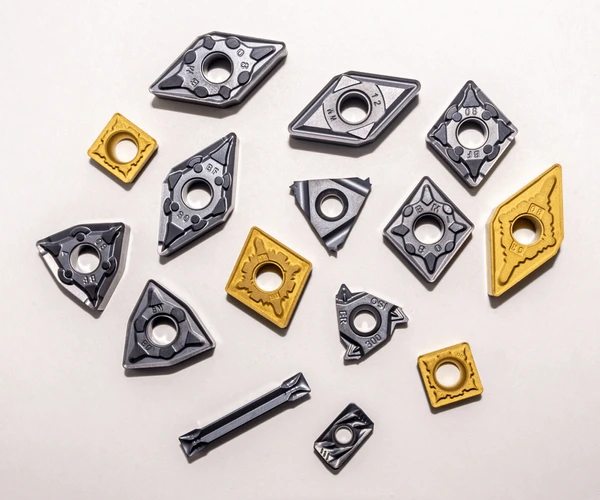
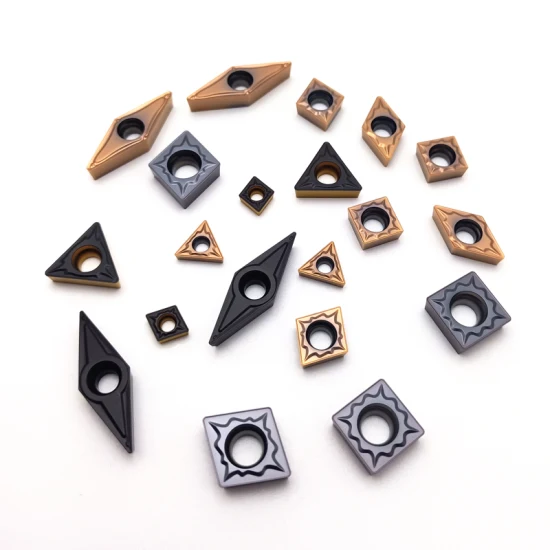
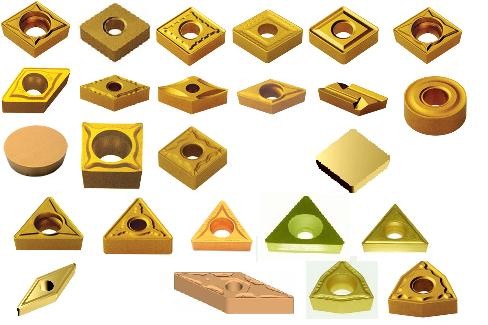
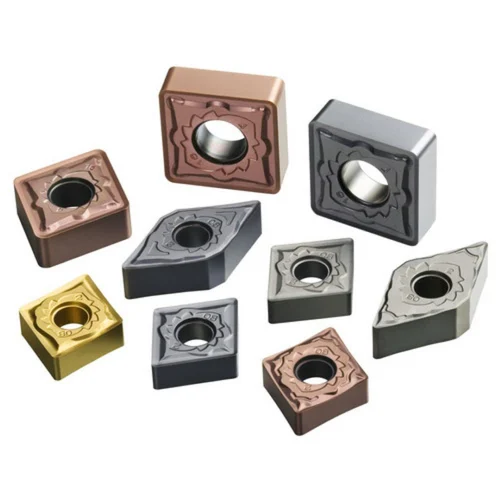
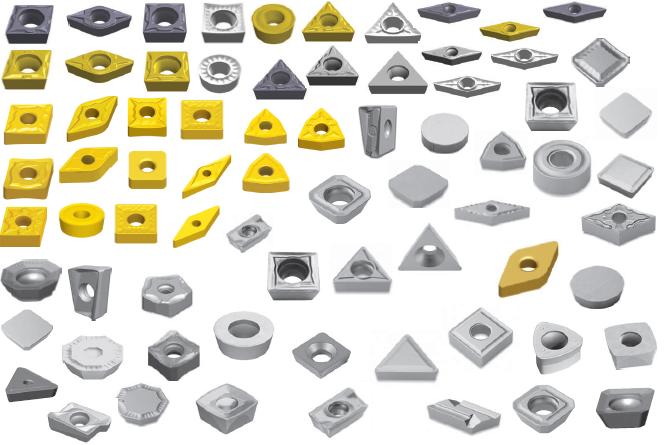

Dureté, solidité et résistance à l'usure des plaquettes en carbure de Trigon
Ce sont des facteurs cruciaux à prendre en compte lors de la sélection des plaquettes pour différentes applications. Voici un tableau comparatif :
| Type | Dureté (HV) | Résistance (MPa) | Résistance à l'usure |
|---|---|---|---|
| TNMG | 1800 | 2800 | Haut |
| TPMG | 1900 | 2700 | Très élevé |
| TCMT | 1700 | 2500 | Haut |
| WNGP | 2000 | 3000 | Très élevé |
| TNGG | 2100 | 2900 | Excellent |
| TPGH | 1600 | 2400 | Haut |
| TNGX | 2200 | 3100 | Exceptionnel |
| TNMM | 1800 | 2800 | Haut |
| TPMR | 1900 | 2700 | Très élevé |
| WCMX | 2000 | 3000 | Très élevé |
Spécifications, tailles, formes et normes des plaquettes en carbure de Trigon
Lors du choix des plaquettes en carbure de trigon, il est essentiel de tenir compte de leurs spécifications, de leurs tailles, de leurs formes et de leur conformité aux normes industrielles. Voici un tableau détaillé :
| Spécifications | Description |
|---|---|
| Norme ISO | L'ISO 1832:2017 spécifie le système de désignation des inserts indexables. |
| Taille | Disponibles dans des tailles allant du plus petit (IC 5mm) au plus grand (IC 25mm). |
| Forme | Triangulaire avec différents angles et préparations des bords. |
| Épaisseur | Elle est généralement comprise entre 3 et 5 mm. |
| Rayon de l'angle | Les options vont des angles vifs aux rayons arrondis (0,2 mm à 1,2 mm). |
| Revêtement | Divers revêtements tels que TiN, TiCN, Al2O3 pour améliorer les performances. |
Fournisseurs et prix des plaquettes en carbure de Trigon
Savoir où s'approvisionner en plaquettes de carbure de trigon et comprendre leurs prix est crucial pour l'approvisionnement. Voici un tableau des principaux fournisseurs et de leurs tarifs :
| Fournisseur | Modèle | Prix (par encart) | Prix de gros |
|---|---|---|---|
| Sandvik Coromant | TNMG 160408-PM | $10.00 | $8.50 (100+ unités) |
| Kennametal | TPMG 160404 | $12.00 | $10.20 (100+ unités) |
| Matériaux Mitsubishi | TCMT 16T308 | $11.00 | $9.30 (100+ unités) |
| ISCAR | WNGP 080404 | $13.50 | $11.70 (100+ unités) |
| Outils Seco | TNGG 160402L | $14.00 | $12.00 (100+ unités) |
| Walter AG | TPGH 090204 | $9.50 | $8.00 (100+ unités) |
| Kyocera | TNGX 120408 | $15.00 | $13.00 (100+ unités) |
| Sumitomo Electric | TNMM 160412 | $10.50 | $9.00 (100+ unités) |
| Tungaloy | TPMR 110304 | $11.50 | $9.80 (100+ unités) |
| Korloy | WCMX 030208 | $12.50 | $10.50 (100+ unités) |
Comment choisir les bonnes plaquettes carbure Trigon
Le choix de la plaquette en carbure trigonale appropriée implique la prise en compte de plusieurs facteurs, notamment le matériau à usiner, le type d'opération et l'état de surface souhaité. Voici un guide pour vous aider à faire le bon choix :
| Facteur | Considérations | Type recommandé |
|---|---|---|
| Matériau | Acier, acier inoxydable, fonte, métaux non ferreux | TNMG, TPMG, TCMT |
| Type d'opération | Ébauche, finition, semi-finition | TNMG (ébauche), TNGG (finition), TNGX (semi-finition) |
| Finition de la surface | Élevé, Moyen, Faible | WNGP (haut), TPMR (moyen), TPGH (bas) |
| Vitesse de coupe | Élevé, Moyen, Faible | WNGP (élevé), TNMG (moyen), TCMT (faible) |
| Vitesse d'alimentation | Élevé, Moyen, Faible | WNGP (haut), TPMR (moyen), TPGH (bas) |
| Profondeur de coupe | Profonde, moyenne, superficielle | TNMG (profond), TNMM (moyen), TCMT (peu profond) |
Avantages et limites des plaquettes en carbure Trigon
Chaque type de plaquette en carbure de trigon a ses propres avantages et limites. Voici une analyse comparative :
| Type | Avantages | Limites |
|---|---|---|
| TNMG | Solide, polyvalent, à bords multiples. | Des forces de coupe plus élevées peuvent nécessiter plus de puissance. |
| TPMG | Coupe régulière, bon contrôle des copeaux. | Moins adapté à l'ébauche. |
| TCMT | Excellent pour la finition des bords tranchants. | Pas idéal pour les coupes lourdes. |
| WNGP | Avances élevées, bons états de surface. | Coût plus élevé. |
| TNGG | Haute précision, excellente finition. | Limité à la coupe légère. |
| TPGH | Arête tranchante, faibles forces de coupe. | Moins durable. |
| TNGX | Haute performance et durabilité. | Coût plus élevé. |
| TNMM | Solide, idéal pour le dégrossissage. | Moins précis. |
| TPMR | Réduction des efforts de coupe, meilleure finition. | Ne convient pas aux applications lourdes. |
| WCMX | Polyvalent, il convient pour l'ébauche et la finition. | Performance modérée dans les deux domaines. |

FAQ
Pour répondre aux questions les plus courantes et fournir des informations supplémentaires, voici une section FAQ :
| Question | Réponse |
|---|---|
| A quoi servent les plaquettes en carbure de trigon ? | Les plaquettes en carbure de Trigon sont utilisées pour la coupe, la mise en forme et la finition de pièces métalliques dans diverses industries telles que l'automobile, l'aérospatiale et le secteur médical. |
| Comment choisir la bonne plaquette en carbure de trigon ? | Tenez compte du matériau, du type d'opération, de l'état de surface, de la vitesse de coupe, de la vitesse d'avance et de la profondeur de coupe. Reportez-vous au guide de sélection fourni. |
| Quels sont les avantages de l'utilisation des plaquettes en carbure de trigon ? | Ils offrent de multiples arêtes de coupe, une grande durabilité, une excellente résistance à l'usure et peuvent traiter une grande variété de matériaux et d'applications. |
| Les plaquettes en carbure de trigon peuvent-elles être utilisées à la fois pour l'ébauche et la finition ? | Oui, certains types comme le WCMX sont polyvalents et conviennent à la fois à l'ébauche et à la finition. |
| Comment optimiser la durée de vie de mes plaquettes en carbure ? | Utilisez la plaquette adaptée au matériau et à l'opération, maintenez des paramètres de coupe appropriés et assurez un entretien régulier de vos outils d'usinage. |
| Les plaquettes en carbure revêtues sont-elles meilleures que les plaquettes non revêtues ? | Les plaquettes revêtues offrent souvent de meilleures performances, une plus grande résistance à l'usure et une durée de vie plus longue, en particulier dans les applications à grande vitesse et à haute température. |
| Quelle est la durée de vie typique d'une plaquette en carbure de trigon ? | La durée de vie varie en fonction de l'utilisation, du matériau et des conditions de coupe, mais les plaquettes durent généralement plus longtemps que les autres types de plaquettes en raison de leurs multiples arêtes de coupe. |
| Comment les plaquettes en carbure de trigon sont-elles fabriquées ? | Ils sont fabriqués à partir d'un mélange de particules de carbure et d'un liant, généralement du cobalt, qui est pressé en forme et fritté à haute température. |
| Les plaquettes en carbure de trigon peuvent-elles être recyclées ? | Oui, les plaquettes en carbure peuvent être recyclées et de nombreux fabricants proposent des programmes de recyclage pour récupérer les matériaux de valeur. |
| Quelles sont les précautions à prendre lors de l'utilisation de plaquettes en carbure ? | Portez toujours un équipement de protection individuelle approprié, suivez les directives du fabricant et veillez à ce que votre équipement d'usinage soit correctement entretenu et réglé. |
Conclusion
Plaquettes en carbure Trigon sont un outil indispensable dans l'usinage moderne, offrant des performances, une durabilité et une polyvalence inégalées. En comprenant les différents types, les applications et les propriétés des matériaux, vous pouvez prendre une décision éclairée et choisir les plaquettes adaptées à vos besoins spécifiques. Que vous travailliez dans l'automobile, l'aérospatiale ou toute autre industrie, les plaquettes en carbure de trigon peuvent vous aider à atteindre la précision et l'efficacité dans vos opérations d'usinage. N'oubliez pas que la clé pour maximiser leur potentiel réside dans la sélection du type approprié pour votre application et dans le maintien de paramètres de coupe adéquats.




